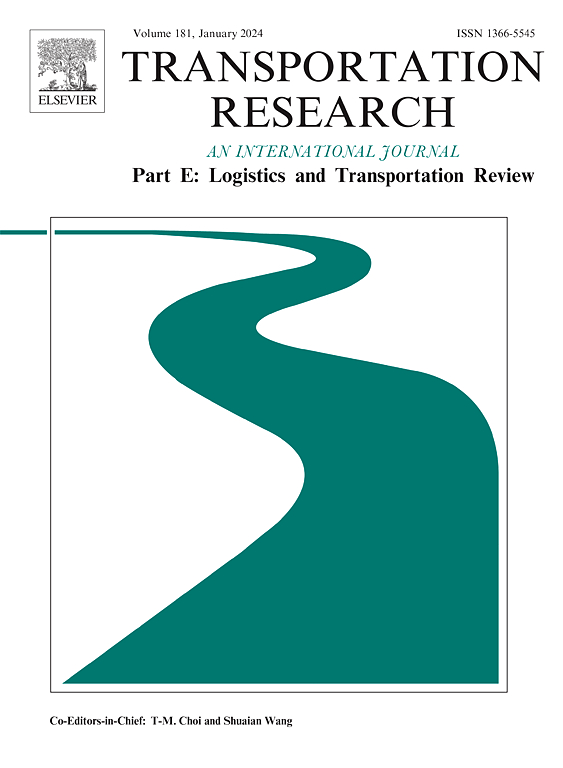Service portfolio design for ship-then-shop subscription in online retailing
IF 8.3
1区 工程技术
Q1 ECONOMICS
Transportation Research Part E-Logistics and Transportation Review
Pub Date : 2025-05-10
DOI:10.1016/j.tre.2025.104152
引用次数: 0
Abstract
Advancements in digital technologies have catalyzed the emergence of the ship-then-shop subscription service, which offers consumers a personalized shopping experience. Using this service, consumers could either receive products regularly at a fixed frequency, i.e., fixed shipment frequency service (FSF), or place orders as needed under on-demand service (ODS) by paying a service fee for each shipment. Nevertheless, suppliers’ service portfolio design is challenged by the information of consumers’ demand occurrence rates, particularly on service fee and service capacity. In this regard, this study strives to understand this problem by developing a tractable model comprising a supplier and a consumer. Consumer demand rate, either high or low, remains private information, leading to the classification of consumers in high and low types. When the difference in reservation utility is moderate, a first-best result can manifest amid information asymmetry. However, when the reservation utility of the H-type consumer is small (large), the supplier must strategically distort the service portfolio to encourage honest choices from consumers. Besides, ODS does not necessarily benefit the supplier even though the exact demand rate information is common knowledge. As the reservation utility of H-type consumers rises, the supplier’s preference for FSF initially grows but subsequently declines. Moreover, it is not necessarily the case that symmetric demand rate information proves strictly better off for the supplier when the reservation utility of the H-type consumer is extremely low. The two preceding findings elucidate the reasons for the coexistence of ODS and FSF modes in practice. Finally, information asymmetry may endow information rent to the H-type consumer.
在线零售中发货-商店订阅的服务组合设计
数字技术的进步催生了“先到后到”的订阅服务,为消费者提供个性化的购物体验。使用此服务,消费者可以定期以固定频率接收产品,即固定送货频率服务(FSF),也可以根据需要在按需服务(ODS)下下单,为每次送货支付服务费。然而,供应商的服务组合设计受到消费者需求发生率信息的挑战,特别是在服务费用和服务能力方面。在这方面,本研究通过开发一个包含供应商和消费者的可处理模型来努力理解这个问题。消费者的需求率,无论是高还是低,仍然是私人信息,导致消费者分为高和低类型。当保留效用的差异适中时,在信息不对称的情况下会出现最优结果。然而,当h型消费者的保留效用较小(较大)时,供应商必须策略性地扭曲服务组合,以鼓励消费者做出诚实的选择。此外,即使确切的需求率信息是众所周知的,ODS也不一定使供应商受益。随着h型消费者保留效用的增加,供应商对FSF的偏好先增加后下降。此外,当h型消费者的保留效用极低时,并不一定证明对称的需求率信息对供应商有利。上述两项发现阐明了ODS和FSF模式在实践中共存的原因。最后,信息不对称可能赋予h型消费者信息租金。
本文章由计算机程序翻译,如有差异,请以英文原文为准。
求助全文
约1分钟内获得全文
求助全文
来源期刊
CiteScore
16.20
自引率
16.00%
发文量
285
审稿时长
62 days
期刊介绍:
Transportation Research Part E: Logistics and Transportation Review is a reputable journal that publishes high-quality articles covering a wide range of topics in the field of logistics and transportation research. The journal welcomes submissions on various subjects, including transport economics, transport infrastructure and investment appraisal, evaluation of public policies related to transportation, empirical and analytical studies of logistics management practices and performance, logistics and operations models, and logistics and supply chain management.
Part E aims to provide informative and well-researched articles that contribute to the understanding and advancement of the field. The content of the journal is complementary to other prestigious journals in transportation research, such as Transportation Research Part A: Policy and Practice, Part B: Methodological, Part C: Emerging Technologies, Part D: Transport and Environment, and Part F: Traffic Psychology and Behaviour. Together, these journals form a comprehensive and cohesive reference for current research in transportation science.

 求助内容:
求助内容: 应助结果提醒方式:
应助结果提醒方式:


